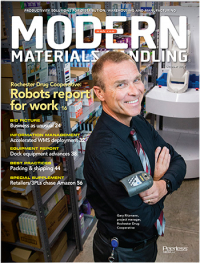60 Seconds with John Santagate, Research director for service robotics at Manufacturing Insights
Modern Materials Handling staff sat down with John Santagate, Research director for service robotics at Manufacturing Insights to talk about the current state of the industry.
John Santagate
Manufacturing Insights
Title: Research director for service robotics
Location: Framingham, Mass.
Experience: More than a decade of experience, including advising leading manufacturing organizations on designing and implementing transformational supply chain innovation.
Duties: The Global Supply Chain Execution and Fulfillment practice provides analysis and advisory services around supply chain technology, business process and cutting edge innovation.
Modern: If any of our readers attended ProMat last April, they would have seen more robotic materials handling solutions than ever. What does the market look like?
Santagate: There are three elements driving market adoption: collaboration, mobility and dexterity. If we’re talking about robots in fulfillment centers, you have a couple of options. One is the facility refit that requires a redesign, like Kiva. Then you have new devices that are autonomously mobile and support the human in the process. That’s mobility and collaboration, and to that point, the shortage of labor jumps out along with what you do during peak demand. You can drop these new robots into an existing facility and maintain workforce continuity. And by dexterity I mean the addition of arms that can move in multiple ways with the ability to grab materials that robots couldn’t grab before.
Modern: Are there solutions that are more mature, or ready for industrialization, than others?
Santagate: Yes. When you think about the robotics market broadly, there are two different types: industrial and service robots. Industrial robots, like robotic welders, have been in the automotive industry since the 1970s and are very mature. Service robots, like mobile collaborative robots, emerged a few years ago. In my view, the technology and ability to scale is there. If you think about a mobile robotic platform, robots moving bins through a facility such as Locus or Fetch are ready. The next stage will be the idea of modularity; that’s where you have a common mobile robotic platform that can move bins, or you can drop in another component like a Baxter robot or a robotic arm, or a simple scanning beacon that can take inventory. Mobile platforms that can be integrated into an existing picking process and work around humans are primed for rapid growth and rapid disruption.
Modern: There was a five- to seven-year lag time before we saw the adoption of some newer materials handling technologies, like shuttle systems. What does the adoption curve for robots look like right now?
Santagate: Here’s the key difference between earlier automation solutions and service robots. Those other solutions often required a physical reconfiguration of your facility because they’re quite massive. Mobile robotics work within your physical constraints. Kiva, which was bought by Amazon, had limitations: You had to reconfigure your floor space; people couldn’t work on the floor with those robots, and you really couldn’t go onto a mezzanine. The new robotics companies are addressing the limitations of those pioneering technologies. So, the thing that will eliminate the 5- to 7-year adoption lag is the fact that you don’t have to do a whole redesign.
Modern: A robotics solution provider recently said to me: “Convincing the skeptical world of supply chain decision-makers is an interesting challenge. Some are starting to get the religion…and it is a religion.” What will be the catalyst for the adoption of robotics in materials handling and supply chain applications?
Santagate: Value. We’re in an environment where speed is key if you’re competing in e-commerce or fulfillment. You have to be faster and efficient. Robotics will allow you to maintain an existing workforce, but then scale to peak without investing in temporary labor and the pain that comes with it. But it’s also getting 20% more productivity from your existing workforce because you take waste out of the process. I believe robotics will bring back the kind of gains we saw in the 80s and 90s with Lean, Six Sigma and other initiatives. The challenge is doing so in a manner that maintains the level of enthusiasm you get from your employees. Right now, robots are not replacing human labor, but augmenting labor.

Article Topics
Robotics News & Resources
Materials Handling Robotics: The new world of heterogeneous robotic integration Walmart deploying autonomous lift trucks at four of its high-tech DCs 2024 Intralogistics Robotics Survey: Robot demand surges Autonomous mobile robots (AMRs) on a mission Up close and personal with mind twisting special purpose robots Gartner foresees sizeable uptake for next-gen humanoid robots A3 bestows Joseph F. Engelberger Robotics Awards to three industry leaders More RoboticsLatest in Materials Handling
Registration open for Pack Expo International 2024 Walmart chooses Swisslog AS/RS and software for third milk processing facility NetLogistik partners with Vuzix subsidiary Moviynt to offer mobility solutions for warehouses Materials Handling Robotics: The new world of heterogeneous robotic integration BSLBATT is looking for new distributors and resellers worldwide Lucas Watson appointed CSO for Körber’s Parcel Logistics business in North America Hyster recognizes Dealers of Distinction for 2023 More Materials HandlingSubscribe to Materials Handling Magazine

Find out what the world's most innovative companies are doing to improve productivity in their plants and distribution centers.
Start your FREE subscription today.
April 2024 Modern Materials Handling

Latest Resources












